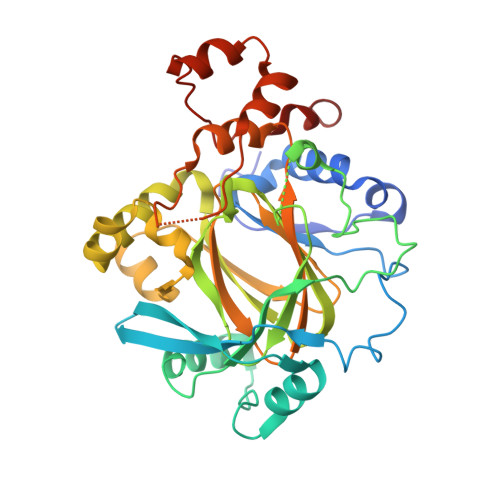C8-substituted pyrido[3,4-d]pyrimidin-4(3H)-ones: Studies towards the identification of potent, cell penetrant Jumonji C domain containing histone lysine demethylase 4 subfamily (KDM4) inhibitors, compound profiling in cell-based target engagement assays.
Le Bihan, Y.V., Lanigan, R.M., Atrash, B., McLaughlin, M.G., Velupillai, S., Malcolm, A.G., England, K.S., Ruda, G.F., Mok, N.Y., Tumber, A., Tomlin, K., Saville, H., Shehu, E., McAndrew, C., Carmichael, L., Bennett, J.M., Jeganathan, F., Eve, P., Donovan, A., Hayes, A., Wood, F., Raynaud, F.I., Fedorov, O., Brennan, P.E., Burke, R., van Montfort, R.L.M., Rossanese, O.W., Blagg, J., Bavetsias, V.(2019) Eur J Med Chem 177: 316-337
- PubMed: 31158747
- DOI: https://doi.org/10.1016/j.ejmech.2019.05.041
- Primary Citation of Related Structures:
6H4O, 6H4P, 6H4Q, 6H4R, 6H4S, 6H4T, 6H4U, 6H4V, 6H4W, 6H4X, 6H4Y, 6H4Z, 6H50, 6H51, 6H52 - PubMed Abstract:
Residues in the histone substrate binding sites that differ between the KDM4 and KDM5 subfamilies were identified. Subsequently, a C8-substituted pyrido[3,4-d]pyrimidin-4(3H)-one series was designed to rationally exploit these residue differences between the histone substrate binding sites in order to improve affinity for the KDM4-subfamily over KDM5-subfamily enzymes. In particular, residues E169 and V313 (KDM4A numbering) were targeted. Additionally, conformational restriction of the flexible pyridopyrimidinone C8-substituent was investigated. These approaches yielded potent and cell-penetrant dual KDM4/5-subfamily inhibitors including 19a (KDM4A and KDM5B Ki = 0.004 and 0.007 μM, respectively). Compound cellular profiling in two orthogonal target engagement assays revealed a significant reduction from biochemical to cell-based activity across multiple analogues; this decrease was shown to be consistent with 2OG competition, and suggests that sub-nanomolar biochemical potency will be required with C8-substituted pyrido[3,4-d]pyrimidin-4(3H)-one compounds to achieve sub-micromolar target inhibition in cells.
- Cancer Research UK Cancer Therapeutics Unit, The Institute of Cancer Research, London, UK.
Organizational Affiliation:




















